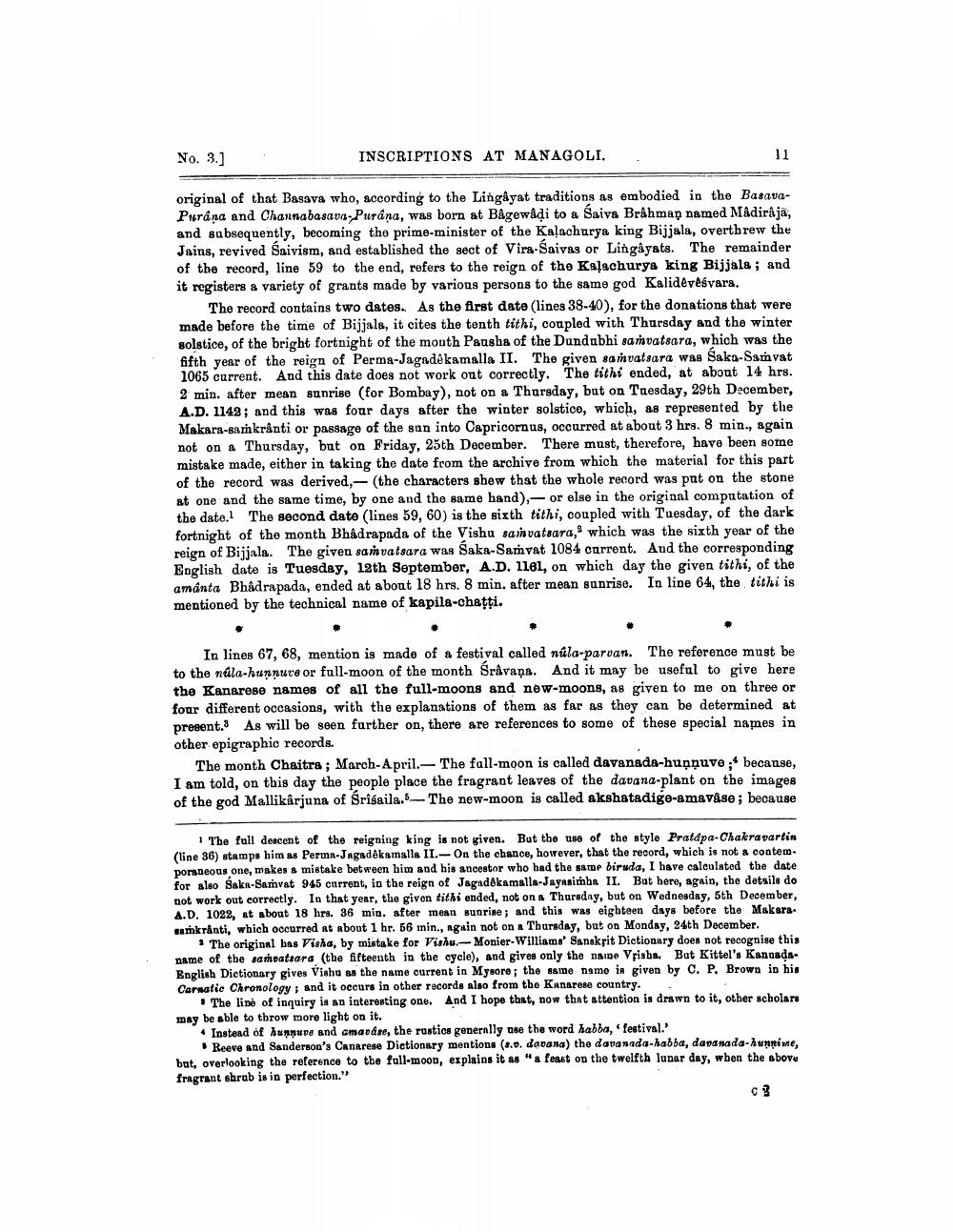________________
No. 3.]
INSCRIPTIONS AT MANAGOLI.
original of that Basava who, according to the Lingayat traditions as embodied in the BasavaPurana and Channabasava. Purana, was born at Bâgewadi to a Saiva Brâhman named Mâdiraja, and subsequently, becoming the prime minister of the Kalacharya king Bijjala, overthrew the Jains, revived Saivism, and established the sect of Vira-Saivas or Lingåyats. The remainder of the record, line 59 to the end, refers to the reign of the Kalachurya king Bijjala; and it registers & variety of grants made by various persons to the same god Kalideveśvara.
The record contains two dates. As the first date (lines 38-40), for the donations that were made before the time of Bijjals, it cites the tenth tithi, coupled with Thursday and the winter solstice, of the bright fortnight of the month Pausha of the Dundabhi samvatsara, which was the fifth year of the reign of Perma-Jagadekamalla II. The given samvatsara was Saka-Samvat 1065 current. And this date does not work out correctly. The tithi ended, at about 14 hrs. 2 min. after mean sunrise (for Bombay), not on a Thursday, but on Tuesday, 29th December, A.D. 1142; and this was four days after the winter solstice, which, as represented by the Makara-sankranti or passage of the san into Capricornus, occurred at about 3 hrs. 8 min., again not on a Thursday, but on Friday, 25th December. There must, therefore, have been some mistake made, either in taking the date from the archive from which the material for this part of the record was derived,- (the characters shew that the whole record was put on the stone at one and the same time, by one and the same hand), - or else in the original computation of the date. The second date (lines 59, 60) is the sixth tithi, coupled with Tuesday, of the dark fortnight of the month Bhadrapada of the Vishu samvatsara, which was the sixth year of the reign of Bijjala. The given samvatsara was Saka-Samvat 1084 carrent. And the corresponding English date is Tuesday, 12th September, A.D. 1181, on which day the given tithi, of the amanta Bhadrapada, onded at about 18 hrs. 8 min, after mean sunrise. In line 64, the tithi is mentioned by the technical name of kapila-chatti.
In lines 67, 68, mention is made of a festival called nula-parvan. The reference must be to the núila-hunnure or full-moon of the month Śråvaņa. And it may be useful to give here the Kanarese names of all the full-moons and new-moons, as given to me on three or four different occasions, with the explanations of them as far as they can be determined at present. As will be seen further on, there are references to some of these special names in other epigraphic records.
The month Chaitra ; March-April. The fall-moon is called davanada-huņņuve ;' becanse, I am told, on this day the people place the fragrant leaves of the davana-plant on the images of the god Mallikarjuna of Srisaila. The new-moon is called akshatadige-amavåse; because
1 The full dercent of the reigning king is not given. But the use of the stylo Pratápa-Chakravartin (line 36) stamps him as Perma-Jagadókamalla II. On the chance, however, that the record, which is not a contem. poraneous one, makes a mistake between him and his ancestor who had the same biruda, I have calculated the date for also Saks-Samvat 945 current, in the reign of Jagadôkamalla-Jayasimba II. Bat here, again, the details do not work out correctly. In that year, the given tithi ended, not on a Thursday, but on Wednesday, 5th December, A.D. 1022, at about 18 hrs. 36 min. after mean sunrise; and this was eighteen days before the Makara. samkranti, which occurred at about 1 hr. 56 min., again not on a Thursday, but on Monday, 24th December
1 The original bas Visha, by mistake for Vishu.-Monier-Williams' Sanskrit Dictionary does not recognise this name of the samvatsara (the fifteenth in the cycle), and gives only the naine Vpisha. But Kittel's KannadaEnglish Dictionary gives Vishu as the name current in Mysore; the same name is given by C. P. Brown in his Carnatic Chronology and it occurs in other records also from the Kanarese country. .
• The line of inquiry is an interesting one. And I hope that, now that attention is drawn to it, other scholars may be able to throw more light on it.
• Instead of unune and amavdse, the rustica generally use the word habba, festival."
Reeve and Sanderson's Canarese Dictionary mentions (8.0. davana) the davanada-habba, daranada-lungime, but, overlooking the reference to the full-moon, explains it as "a feast on the twelfth lunar day, when the above fragrant shrub is in perfection."
C3




